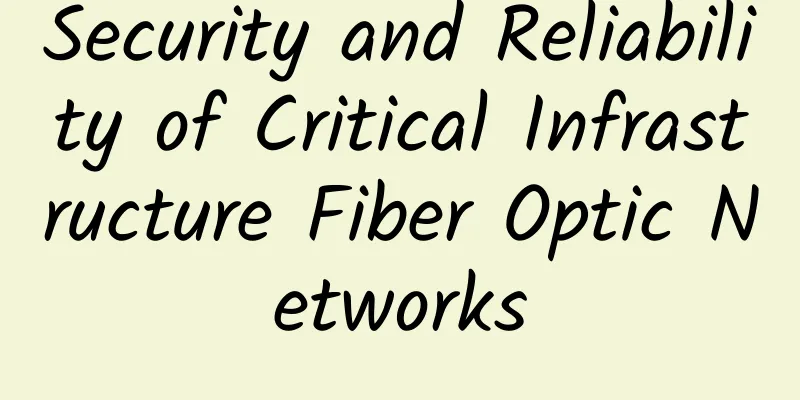Security and Reliability of Critical Infrastructure Fiber Optic Networks

|
Figure 1: Growing Asia Pacific fiber optic market The normal operation of a country requires the support of critical infrastructure, and we are not just talking about physical infrastructure. It takes all departments to work together to make the engine of the country run. Departments dealing with critical infrastructure (such as water supply systems, power grids, and transportation networks) are often vital gears that require uninterrupted connectivity using fiber optic networks. Why is fiber considered an excellent choice for critical infrastructure?To ensure that these critical infrastructures operate smoothly, seamless communications are key to handling the massive amounts of data generated every day. Fiber optics has become the most reliable option for running critical infrastructures. As critical infrastructure systems process large amounts of data using smart devices and modern system networks, faster communication networks such as 5G are needed. This advanced technology requires a powerful 5G fiber backhaul network. Security: A major concern for critical infrastructure fiberHackers are increasingly sophisticated, viewing critical infrastructure systems as a gold mine of exploitable data. Without secure communications networks, critical infrastructure systems could collapse if malicious actors gain control of vulnerabilities. Fiber optic networks are more secure than traditional communications technologies with the following key differences:
Why are fiber optic networks more reliable for critical infrastructure systems?Figure 2: Fiber transmission capacity Today’s critical infrastructure systems require massive amounts of bandwidth to accommodate hundreds of GB of data traffic and the surging number of devices on the network. To ensure uninterrupted connectivity and high data transfer speeds, building an efficient 5G fiber backhaul network is critical. The following are the main areas where fiber optics has high reliability in critical infrastructure systems: 1. High data transmission capacity – Single-mode and multimode optical fibers are extremely effective in transmitting large amounts of data, from short distances to several kilometers at speeds of up to 160Gbit/s. 2. Low latency - One of the most critical requirements of 5G networks is low latency. Previous generations of communication technology simply could not handle large amounts of data and maintain their low latency levels. However, with a network built on optical fiber, latency levels have been significantly reduced to enable near real-time critical operations. 3. Lower attenuation – Signal loss due to various factors is the most common problem faced by copper networks. Fiber optic networks, on the other hand, offer better performance at a much lower attenuation level. Challenges of Maintaining Fiber Network Security and ReliabilityFigure 3: Overall diagram of a typical optical access network Despite the increasing deployment of fiber by enterprises and critical infrastructure organizations, several challenges hinder the adoption of fiber networks. CybersecurityDespite the high security levels, optical fiber is still vulnerable. Therefore, sophisticated security measures such as encryption and intrusion detection systems are recommended to protect 5G optical fiber backhaul networks. Physical SecurityVandalism and theft pose a significant risk to fiber optic networks. Such incidents can cause physical damage that disrupts the functionality of the network. Steps must be taken to prevent such incidents. Where does the future lead us?Considering the various promises and challenges that fiber networks present, it’s fair to say that critical infrastructure systems are looking to fiber market leaders to ensure their 5G fiber backhaul networks are ready for future challenges and needs. Frequently asked questions1. Why do critical infrastructure systems need fiber connectivity? Because modern systems such as education, healthcare, government operations, power and water systems process large amounts of data, they require fiber optic networks to meet high computing demands. 2. How to prevent external interference in fiber optic networks? Fiber-optic networks use pulses of light to transmit data inside glass fibers, making them immune to outside interference. In addition, hacking into the network by splicing cables is extremely challenging. 3. What are the different challenges in fiber optic network deployment and maintenance? Professional hacking incidents, physical events such as theft and vandalism, and natural disasters such as earthquakes and floods can hinder the adoption of fiber optic networks. |
<<: What types of single-mode optical fiber are used?
>>: Comprehensive Guide to Fiber Optic Boxes
Recommend
edgeNAT VPS/dedicated servers are 20% off for monthly payment and 30% off for annual payment. Hong Kong VPS bandwidth upgrade price remains unchanged
edgeNAT is a Chinese host provider established in...
Xunfang and Huawei join hands to enter the era of big service 2.0, four key words to achieve consistent service experience
[51CTO.com original article] On a weekend in earl...
LOCVPS Double 11 Preheating: 30% off for all items/50% off for some items, top up 300 yuan and get 50 yuan free
LOCVPS (Global Cloud) is a Chinese VPS service pr...
After the construction of 5G, 4G Internet access on mobile phones has become slower. Is this really a marketing trick of the operators?
Preface [[332244]] Recently, many customers and f...
The long-awaited 5G messaging trial will be launched in late October or early November
"China Unicom and China Telecom are working ...
What is blockchain and what impact does it have on data centers and cloud computing?
Today, more and more applications are causing the...
6 Examples of How 5G Can Improve IoT Deployments
As digital transformation is in full swing, the n...
RepriseHosting: $25.97/month-L5640, 16G memory, 1TB hard disk, 20TB/1Gbps, Seattle data center
This is a promotional activity released by the me...
Failure to modernize data center infrastructure increases costs and risk of downtime
Today's data centers are more dynamic than ev...
5G spending of the three major operators decreased, and the number of package users increased
The three major operators recently released their...
The average monthly salary of 5G talents exceeds 14,000 yuan, and Beijing, Shanghai and Shenzhen are most in need of talent
As 5G commercialization approaches, the demand fo...
HostHatch: 2TB hard drive VPS annual payment of $50, 8G memory VPS annual payment from $35
HostHatch is a foreign hosting company founded in...
Understand the ins and outs of DNS in one article
[[333115]] 1. Background By the late 1970s, the A...
Outlook for domestic 5G development in 2021 (Part 3): Opportunities
From the official launch of commercial use in 201...
Symantec launches new information protection solution to automatically encrypt critical enterprise data
The Symantec Information Centric Security solutio...









